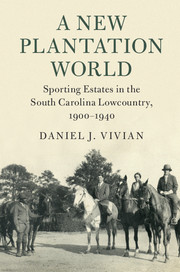Book contents
- A New Plantation World
- Cambridge Studies on the American South
- A New Plantation World
- Copyright page
- Contents
- Figures
- Acknowledgments
- Introduction
- 1 Discovering the Lowcountry
- 2 Creating Plantations for Sport and Leisure
- 3 New Lowcountry, New Plantations
- 4 Creating Mulberry Plantation, 1915–1935
- 5 Medway Plantation
- 6 Representing a New Plantation World
- 7 Plantation Life
- Epilogue
- Bibliography
- Index
- References
Bibliography
Published online by Cambridge University Press: 20 February 2018
- A New Plantation World
- Cambridge Studies on the American South
- A New Plantation World
- Copyright page
- Contents
- Figures
- Acknowledgments
- Introduction
- 1 Discovering the Lowcountry
- 2 Creating Plantations for Sport and Leisure
- 3 New Lowcountry, New Plantations
- 4 Creating Mulberry Plantation, 1915–1935
- 5 Medway Plantation
- 6 Representing a New Plantation World
- 7 Plantation Life
- Epilogue
- Bibliography
- Index
- References
Summary

- Type
- Chapter
- Information
- A New Plantation WorldSporting Estates in the South Carolina Lowcountry, 1900–1940, pp. 319 - 342Publisher: Cambridge University PressPrint publication year: 2018



